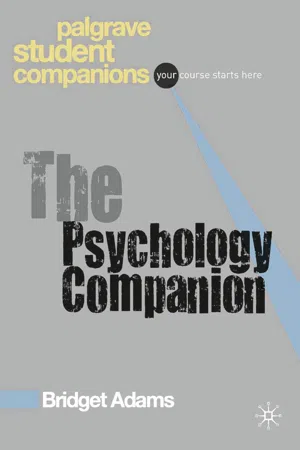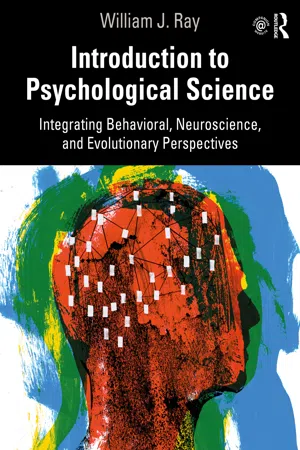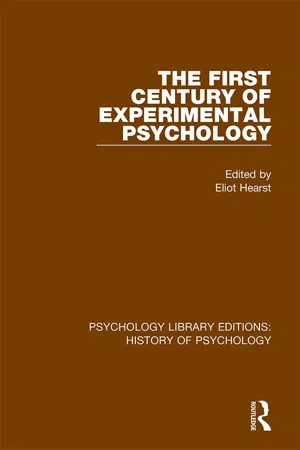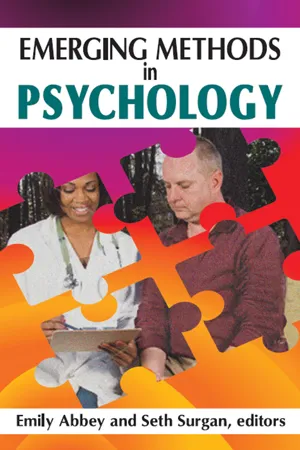Psychology
Scientific Processes
Scientific processes in psychology refer to the systematic methods used to conduct research and gather empirical evidence. This includes formulating hypotheses, designing experiments, collecting and analyzing data, and drawing conclusions based on the evidence. These processes are essential for advancing knowledge and understanding in the field of psychology.
Written by Perlego with AI-assistance
Related key terms
6 Key excerpts on "Scientific Processes"
- eBook - ePub
- Bridget Adams(Author)
- 2009(Publication Date)
- Bloomsbury Academic(Publisher)
2 approaches in psychology approaches 2.1 Ways of looking at the behaviour and minds of people 2.2 Core approaches 2.3 Other approaches 2.1 Ways of looking at the behaviour and minds of people Scientific nature of enquiry Like all methods of enquiry, in history, philosophy, literature and so on, the purpose of scientific research is to increase our knowledge and understanding. All science is concerned with similarities between things in the search for the underlying ‘oneness’ of the universe (see Metaphysics below) and in defining the differences that enable us to label and classify. Some definitions of science Allport (1947): [Science provides] understanding, prediction and control above the levels achieved by unaided common sense. Wright et al (1970): The term ‘experimental psychology’ has been used for several decades to refer to scientific psychology, which uses mainly experimental methods, as opposed to kinds of psychology based mainly on philosophic or therapeutic considerations. . . . Psychology bridges the gap between the biological and the social sciences. Searle (1989: 11): All sorts of disciplines that are quite unlike physics and chemistry are eager to call themselves ‘sciences’. A good rule of thumb to keep in mind is that anything that calls itself ‘science’ probably isn’t – for example, Christian science, or military science, and possibly even cognitive science or social science. . . . There is only knowledge and understanding. . . . some disciplines are more systematic than others, and we might want to reserve the word ‘science’ for them. Collingwood (1998: 4): The word ‘science’, in its original sense, which is still its proper sense not in the English language alone but in the international language of European civilization, means a body of systematic or orderly thinking about a determinate subject matter. . . . There is also a slang sense, unobjectionable (like all slang) on its lawful occasions. . - eBook - ePub
Introduction to Psychological Science
Integrating Behavioral, Neuroscience and Evolutionary Perspectives
- William J. Ray(Author)
- 2021(Publication Date)
- Routledge(Publisher)
The story of Clever Hans shows us that all organisms, including humans, are sensitive to their environment. This is true whether we are interacting with other people or being part of an experiment. Thus, in psychological experiments there are a number of opportunities for those who are researchers to influence those who are participants in ways that were never intended. Participants can also influence researchers. For example, participants in experiments may respond to their own ideas or internal demands rather than those of the experiment itself.What Are the Methods of Science?The methods of science closely parallel our ways of learning about the world. We interact with the world and gain new knowledge and understanding of what we experience. However, in doing psychological research, we do this in a more organized and logical manner. We may observe and describe what we see, which is referred to qualitative research. We can also measure and report the number of specific factors that can be used in a mathematical manner, which is referred to as quantitative research. The scientific approach emphasized in this chapter will describe both qualitative and quantitative approaches. In both, researchers approach a particular question or topic in a logical manner. We can think about a critical approach to science in terms of four stages.- Scientists first begin with an idea or expectation. A formally stated expectation is called a hypothesis. The scientist says, “I expect this to happen under these conditions,” and thus states the hypothesis.
- Second, scientists look to experience to evaluate the accuracy of their ideas or expectations about the world. That is, they try to find or create the situation that will allow them to observe what they are interested in studying.
- Through observation and experimentation, scientists can begin to evaluate their ideas and expectations about the world. Learning about the world through observation and experimentation is an example of empiricism
- eBook - ePub
- Elliot Hearst, Eliot Hearst(Authors)
- 2019(Publication Date)
- Routledge(Publisher)
Investigators close to the mainstream of experimental psychology have been as aware as others of these apparent paradoxes, but rather than being swayed by philosophical arguments they have tended to seek constructive solutions. One form that these efforts have taken during the last decade is the distinction between structural and control processes elucidated by Atkinson and Shiffrin (1968). The distinction took hold rapidly among cognitive psychologists and those associated with the information-processing movement and, by the end of the decade, has even begun to penetrate investigations of animal learning and memory. By control processes one understands the habits (especially pertaining to stimulus selection), criteria, strategies, and heuristics that enter into virtually all behavior of much intrinsic interest outside of the laboratory and certainly all that would be termed cognitive or intellectual in the usual meaning of these terms.The description of these control processes and a characterization of the way they develop and enter into performance is a major task for experimental as well as developmental psychology and indeed demands the complementary contribution of these two subdisciplines. Further, the fertility of psychology in generating practical applications depends increasingly on appreciation of the role of control processes. Theories and models of intellectual capacity, memory structure, information-processing stages, and the like would be remote from reality if unaccompanied by concern for the way control processes are expressed in behavior.Nonetheless, description of control processes alone would give us a science like botany without biochemistry, or like astronomy without astrophysics—all description and no understanding of mechanism, all phenotype and no genotype. Everyone, psychologist and nonpsychologist alike, is impressed with the diversity of behavior within as well as across species, within as well as between individuals, and with the need for a picture of the way diversity develops over time. But there is room also to be impressed with constancies. There proves to be much that is common across members of a species, in behavior as well as in structure. People develop not only different personalities but also different physical appearances, as a consequence of different genetic makeups, life-styles, nutritional habits, and the like; but nonetheless in many ways all are fundamentally alike. The diversity of behavior unfolds within constraints set by structural characteristics of the mind and the brain. Thus the way different histories lead to variations in ability and function, and the constraints that keep this variation within rather strict bounds, both need to be understood, whether one’s interest is in understanding cognitive development or general psychological theory. - eBook - ePub
Observing Children in Their Natural Worlds
A Methodological Primer, Third Edition
- Anthony D. Pellegrini, Frank Symons, John Hoch(Authors)
- 2012(Publication Date)
- Psychology Press(Publisher)
HAPTER 2Science, Psychology, and Research
A t first blush, some readers may be taken aback by the use of the word “science” in the title of this chapter. Don't be, because I use the term “science” in a general sense whereby hypotheses are first generated and then tested, in a cycle of induction and deduction. Hypotheses, as you'll see, are educated “hunches,” derived from theory, that are held up for scrutiny: Does the evidence support or fail to support the hypothesis? Direct observations are a crucial part of this process for both basic research and for solving problems in everyday settings, such as in schools and families. In this chapter, I will discuss, generally, the nature of science and the scientific method, and how they are applicable to observational methods in the context of social science research. Positioning social science as “science,” rather than, say art, situates it in a context with extant rules and conventions for conducting research. Indeed, different definitions of science limit those activities which would be considered “research.” This chapter will serve to orient you to basic assumptions associated with conducting scientific research.What is Science?
Science, and scientific research, helps us to understand the “nature of things,” though very few today would suggest that it enables us to approach knowing an absolute and unchanging truth. Additionally, scientific research can also have practical implications. By practical I mean, scientific research can be used to address and possibly solve problems in everyday life, whether they be in the work place, and at or in school. Sometimes these two areas of research are dichotomized as “basic” and “applied” science.Basic science is typically associated with generating and testing hypotheses derived from theory. Theory, as will be discussed, is an overarching explanation for some phenomenon. Basic science can be descriptive, explanatory, or predictive. Applied science, on the other hand, uses the scientific method to solve everyday problems, such as workplace bullying or children's noncompliance at school and home. As you will see, however, the basic vs applied dichotomy does have fuzzy boundaries. For example, you could invoke a theory (e.g. social cognitive theory), in the service of solving a practical problem (workplace bullying), to make predictions about causes (e.g. bosses tolerate and model bullying) and remediation (e.g. have positive models and do not reinforce negative models). If these predictions are framed in terms of hypotheses derived from a theory, the outcomes are certainly “basic” though possibly, as you will see below, at a lower level of abstraction than other hypotheses. - eBook - ePub
- Seth Surgan(Author)
- 2017(Publication Date)
- Routledge(Publisher)
The authors in this volume also share a focus on theory and theory-building, as opposed to generalizing empirical findings to a population. Across the chapters, we can hear stories of research being done in order to construct, refine, or reject theoretical descriptions and models of specific psychological processes. This fact has implications for the process of generalization (to the developing model through abduction, rather than to the population through induction; Valsiner [2000, chap. 5]) and for sampling (of individual cases for their ability to illuminate aspects of the proposed process, rather than sampling for the purpose of representing a population; Sato et al. [2007]) that have been discussed elsewhere and by other authors.Here, it is worth noting the difference in the level to which theories must be developed before research proceeds. In the standard hypothetico-deductive framework, there is little requirement for theoretical elaboration. Instead of theory, a set of suggestive findings from previous research may be provided as motivation for a particular study. For example, a study of the correlation between X, Y, and Z might be prefaced by a review of relevant findings about the correlations X and Y and between Y and Z, followed by a hypothesis about the relationships among X, Y, and Z. Such an approach is not driven by theory and does not contribute to psychology’s basic understanding of how the human mind works.Although there is little theoretical elaboration required for such a study, there are heavy methodological demands of a particular kind. Valid and reliable measures must be found or built and those measures must be administered under controlled conditions. Such studies may facilitate the prediction of observable behavior, which is a purpose that psychology adopted as part of its history of becoming a “socially useful science,” as Valsiner discusses in his Foreword to this volume. As a socially useful science, the goals of the users (i.e., powerful institutions such as governments and schools) are what determine the goals of the discipline. If the goal of psychology is the prediction and control of behavior, then the criterion against which psychological knowledge will be judged is the accuracy of the predictions. In this framework, there is little value placed on understanding why or how such actions appear in the first place. The value of the study is established in methodological terms: the precision of method, the quality of the sample, etc., rather than on the depth of knowledge that can come from the study. The turn to science-as-method has distracted psychology from the fundamental purpose of methodology: the construction of knowledge about how the human mind works. - eBook - ePub
Education and Psychology in Interaction
Working With Uncertainty in Interconnected Fields
- Brahm Norwich(Author)
- 2002(Publication Date)
- Routledge(Publisher)
Practitioner psychologists also use professional skills which have little grounding in the discipline of psychology. This means that there is a need to use psychology to make sense of the problems professional psychologists have to deal with. Without this, professional psychologists find it hard to give a rationale for their service contribution as distinct from the services of other allied non-psychologist professional groups. Watts does not make this particular point, but it has special relevance to the educational psychology which will be discussed in the next two chapters. But Watts does make the important point that the gap between basic research and applied professional psychology has a strong methodological basis to it. He considers that unless there is better integration between experimental and interpretive methods, research and professional psychologists are less likely to collaborate. This means that practitioner psychologists who make use of interpretive processes should be more familiar with systematic qualitative methods, which they can learn from social psychologists. He argues that experimental work has some relevance, especially in the single-case experimental design mode. Practitioners also need to be conversant with experimental results from basic research which have applicability to their work, and could collect empirical data themselves. But basic research psychologists also need a methodological integration. This arises from the difference between the process of generating fruitful ideas, or what Popper called insightful conjectures, and the process of testing them. This is sometimes called the difference between scientific discovery and verification. The context of discovery has been linked to a more intuitive grasp of phenomena and a familiarity with them. Linking back to Bruner’s account of the complementary relationship between explaining and interpreting, causal explanatory research can be considered to need more open-ended interpretive processes.Concluding comments
I have explored in this chapter the key question within psychology of how we can be true to our notions of our humanity, to our human values and to a coherent concept of science. This raises important and difficult questions about the point of calling a field of study ‘scientific’. The theoretical diversity within psychology, which was introduced in the previous chapter, has been explored further. This showed that no simple dichotomies can be discerned between broad kinds of psychological theories. Mechanistic theories are so diverse that they are not simply distinguishable from alternative theories involving constructivist and holist principles. Psychology’s connections with philosophical and value questions were also discussed. The arguments about ideological issues in psychology were accepted as showing that values were at the foundation of the psychological field of study. Two broad sorts of values were suggested as helping us understand some of the differences within the field: epistemological values of participant or spectator perspectives and the well-being values of progressive or conservative tendencies. I argued that adopting exclusive positions with respect to these value differences engenders splitting and the emergence of similarly exclusive opposite positions. A purist, positivist scientific spectator approach to psychology engenders a similarly hard-line intepretivist participant approach. The case for seeing connections between participant and spectator perspectives was seen as compelling because the objects of psychology—ourselves as human beings—are also subjects who have intentionality. I also noted that a causal science model has had and continues to have a progressive form which seeks to identify alterable causal variables and promote human well-being. That well-being values influence the adoption of epistemological positions also needs to be recognised. But a causal scientific perspective, though sometimes associated with conservative values, is not necessarily so. Identifying causal mechanisms can support progressive values; they can empower and improve human conditions.
Index pages curate the most relevant extracts from our library of academic textbooks. They’ve been created using an in-house natural language model (NLM), each adding context and meaning to key research topics.





